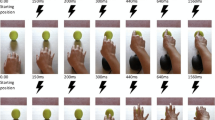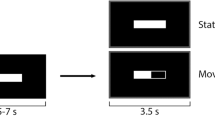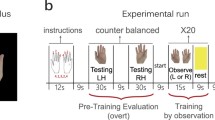Abstract
While many of our motor skills are acquired through physical practice, we can also learn how to make movements by observing others. For example, individuals can learn how to reach in novel dynamical environments (‘force fields’, FF) by observing the movements of a tutor. Previous neurophysiological and neuroimaging studies in humans suggest a role for the motor system in motor learning by observing. Here, we tested the role of primary motor cortex (M1) in motor learning by observing. We used single-pulse transcranial magnetic stimulation to elicit motor-evoked potentials (MEPs) in hand muscles at rest. MEPs were elicited before and after participants observed either a video showing a tutor adapting her reaches to an FF or a control video showing a tutor performing reaches in an unlearnable FF. During MEP acquisition, participants fixated a crosshair while their hand muscles were relaxed. We predicted that observing motor learning would result in greater increases in offline M1 excitability compared to observing movements that did not involve learning. We found that observing FF learning resulted in subsequent increases in MEP amplitudes recorded from right first dorsal interosseous and right abductor pollicis brevis muscles at rest. There were no changes in MEP amplitudes after control participants observed a tutor performing similar movements but not learning. The observed MEP changes can thus be specifically linked to observing motor learning. These results are consistent with the idea that observing motor learning produces functional changes in M1, corticospinal networks or both.




Similar content being viewed by others
Explore related subjects
Discover the latest articles and news from researchers in related subjects, suggested using machine learning.Abbreviations
- FF:
-
Force field
- CW:
-
Clockwise
- CCW:
-
Counterclockwise
- PD:
-
Maximum perpendicular deviation
- TMS:
-
Transcranial magnetic stimulation
- MEP:
-
Motor-evoked potential
References
Alaerts K, Senot P, Swinnen SP, Craighero L, Wenderoth N, Fadiga L (2010) Force requirements of observed object lifting are encoded by the observer’s motor system: a TMS study. Eur J Neurosci 31:1144–1153
Bernardi NF, Darainy M, Bricolo E, Ostry DJ (2013) Observing motor learning produces somatosensory change. J Neurophysiol 110:1804–1810
Borroni P, Baldissera F (2008) Activation of motor pathways during observation and execution of hand movements. Soc Neurosci 3:276–288
Brown LE, Wilson ET, Gribble PL (2009) Repetitive transcranial magnetic stimulation to the primary motor cortex interferes with motor learning by observing. J Cogn Neurosci 21:1013–1022
Buccino G, Binkofski F, Fink GR, Fadiga L, Fogassi L, Gallese V, Seitz RJ, Zilles K, Rizzolatti G, Freund H-J (2001) Action observation activates premotor and parietal areas in a somatotopic manner: an fMRI study. Eur J Neurosci 13:400–404
Buckingham G, Wong JD, Tang M, Gribble PL, Goodale MA (2014) Observing object lifting errors modulates cortico-spinal excitability and improves object lifting performance. Cortex 50:115–124
Caspers S, Zilles K, Laird AR, Eickhoff SB (2010) ALE meta-analysis of action observation and imitation in the human brain. Neuroimage 50:1148–1167
Cothros N, Köhler S, Dickie EW, Mirsattari SM, Gribble PL (2006) Proactive interference as a result of persisting neural representations of previously learned motor skills in primary motor cortex. J Cogn Neurosci 18:2167–2176
Cross ES, Kraemer DJM, Hamilton AF, de C, Kelley, Grafton WM (2009) ST. Sensitivity of the action observation network to physical and observational learning. Cereb Cortex 19:315–326
de Beukelaar TT, Alaerts K, Swinnen SP, Wenderoth N (2016) Motor facilitation during action observation: The role of M1 and PMv in grasp predictions. Cortex 75:180–192
Di Pellegrino G, Fadiga L, Fogassi L, Gallese V, Rizzolatti G (1992) Understanding motor events: a neurophysiological study. Exp Brain Res 91:176–180
Fadiga L, Fogassi L, Pavesi G, Rizzolatti G (1995) Motor facilitation during action observation: a magnetic stimulation study. J Neurophysiol 73:2608–2611
Flanagan JR, Vetter P, Johansson RS, Wolpert DM (2003) Prediction precedes control in motor learning. Curr Biol 13:146–150
Gallese V (1998) Mirror neurons and the simulation theory of mind-reading. Trends Cogn Sci 2:493–501
Gallese V, Fadiga L, Fogassi L, Rizzolatti G (1996) Action recognition in the premotor cortex. Brain 119:593–609
Hallett M (2017) Smart brain stimulation. Clin Neurophysiol 128:839–840
Heyes CM, Foster CL (2002) Motor learning by observation: evidence from a serial reaction time task. Q J Exp Psychol A 55:593–607
Hickok G (2009) Eight problems for the mirror neuron theory of action understanding in monkeys and humans. J Cogn Neurosci 21:1229–1243
Keel JC, Smith MJ, Wassermann EM (2001) A safety screening questionnaire for transcranial magnetic stimulation. Clin Neurophysiol 112(4):720
Klem GH, Lüders HO, Jasper HH, Elger C (1999) The ten-twenty electrode system of the International Federation. The International Federation of Clinical Neurophysiology. Electroencephalogr Clin Neurophysiol Suppl 52:3–6
Koch G, Versace V, Bonnì S, Lupo F, Lo Gerfo E, Oliveri M, Caltagirone C (2010) Resonance of cortico–cortical connections of the motor system with the observation of goal directed grasping movements. Neuropsychologia 48:3513–3520
Mattar AAG, Gribble PL (2005) Motor learning by observing. Neuron 46:153–160
McGregor HR, Gribble PL (2015) Changes in visual and sensory-motor resting-state functional connectivity support motor learning by observing. J Neurophysiol 114:677–688
McGregor HR, Gribble PL (2017) Functional connectivity between somatosensory and motor brain areas predicts individual differences in motor learning by observing. J Neurophysiol 118:1235–1243
McGregor HR, Cashaback JGA, Gribble PL (2016) Functional plasticity in somatosensory cortex supports motor learning by observing. Curr Biol 26:921–927
Montagna M, Cerri G, Borroni P, Baldissera F (2005) Excitability changes in human corticospinal projections to muscles moving hand and fingers while viewing a reaching and grasping action. Eur J Neurosci 22:1513–1520
Naish KR, Houston-Price C, Bremner AJ, Holmes NP (2014) Effects of action observation on corticospinal excitability: muscle specificity, direction, and timing of the mirror response. Neuropsychologia 64:331–348
Palmer E, Ashby P (1992) Corticospinal projections to upper limb motoneurones in humans. J Physiol 448:397–412
Plautz EJ, Milliken GW, Nudo RJ (2000) Effects of repetitive motor training on movement representations in adult squirrel monkeys: role of use versus learning. Neurobiol Learn Mem 74:27–55
Prinz W (2006) What re-enactment earns us. Cortex 42:515–517
Rizzolatti G, Fadiga L, Gallese V, Fogassi L (1996) Premotor cortex and the recognition of motor actions. Cogn Brain Res 3:131–141
Stefan K, Cohen LG, Duque J, Mazzocchio R, Celnik P, Sawaki L, Ungerleider L, Classen J (2005) Formation of a motor memory by action observation. J Neurosci 25:9339–9346
Strafella AP, Paus T (2000a) Modulation of cortical excitability during action observation. Neuroreport 11:2289–2292
Strafella AP, Paus T (2000b) Modulation of cortical excitability during action observation: a transcranial magnetic stimulation study. Neuroreport 11:2289–2292
Turella L, Pierno A, Tubaldi F, Castiello U (2009) Mirror neurons in humans: consisting or confounding evidence? Brain Lang 108:10–21
Vesia M, Davare M (2011) Decoding action intentions in parietofrontal circuits. J Neurosci 31:16491–16493
Watkins KE, Strafella AP, Paus T (2003) Seeing and hearing speech excites the motor system involved in speech production. Neuropsychologia 41:989–994
Acknowledgements
The authors wish to thank Dinant Kistemaker for the figure showing the robotic manipulandum setup. This work was supported by the Natural Sciences and Engineering Research Council of Canada, and by the National Institute of Child Health and Human Development R01 HD075740.
Author information
Authors and Affiliations
Corresponding author
Ethics declarations
Conflict of interest
The authors report no financial interests or conflicts of interests.
Rights and permissions
About this article
Cite this article
McGregor, H.R., Vesia, M., Rinchon, C. et al. Changes in corticospinal excitability associated with motor learning by observing. Exp Brain Res 236, 2829–2838 (2018). https://doi.org/10.1007/s00221-018-5339-7
Received:
Accepted:
Published:
Issue Date:
DOI: https://doi.org/10.1007/s00221-018-5339-7
Keywords
Profiles
- Paul L. Gribble View author profile




